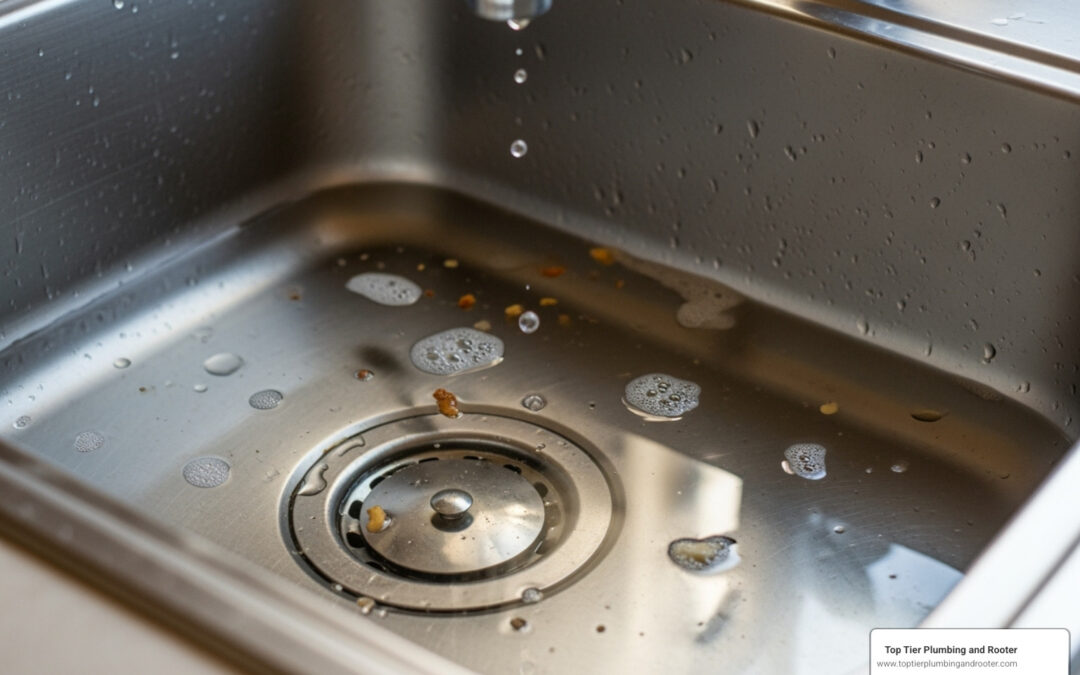Why Standing Water in Your Drains Demands Immediate Action
Drainage blockage removal is one of the most common plumbing challenges homeowners face, and that standing water in your sink isn’t just annoying – it’s a sign of a problem that needs fixing fast.
Quick Solutions for Blocked Drains:
- Hot water flush – Pour boiling water down the drain in 2-3 stages
- Baking soda and vinegar – Mix equal parts, let sit 15 minutes, flush with hot water
- Plunger method – Use proper technique with cup plunger for sinks
- Drain snake – Insert and twist to break up deeper clogs
- Professional help – Call when DIY methods fail or multiple drains are affected
Nothing ruins your morning routine quite like finding your kitchen sink won’t drain or your shower has turned into a mini swimming pool. Standing water is more than just an inconvenience – it can lead to unpleasant odors, bacteria growth, and even property damage if left untreated.
The good news? Most drain blockages can be cleared with simple household items and basic techniques. According to plumbing research, the most common culprits behind blocked drains are grease buildup, hair accumulation, food particles, and everyday items that shouldn’t go down your pipes.
Whether you’re dealing with a slow-draining bathroom sink or a completely blocked kitchen drain, this guide will walk you through proven methods to get your water flowing freely again. We’ll start with the gentlest approaches and work up to more advanced techniques, so you can tackle the problem safely and effectively.
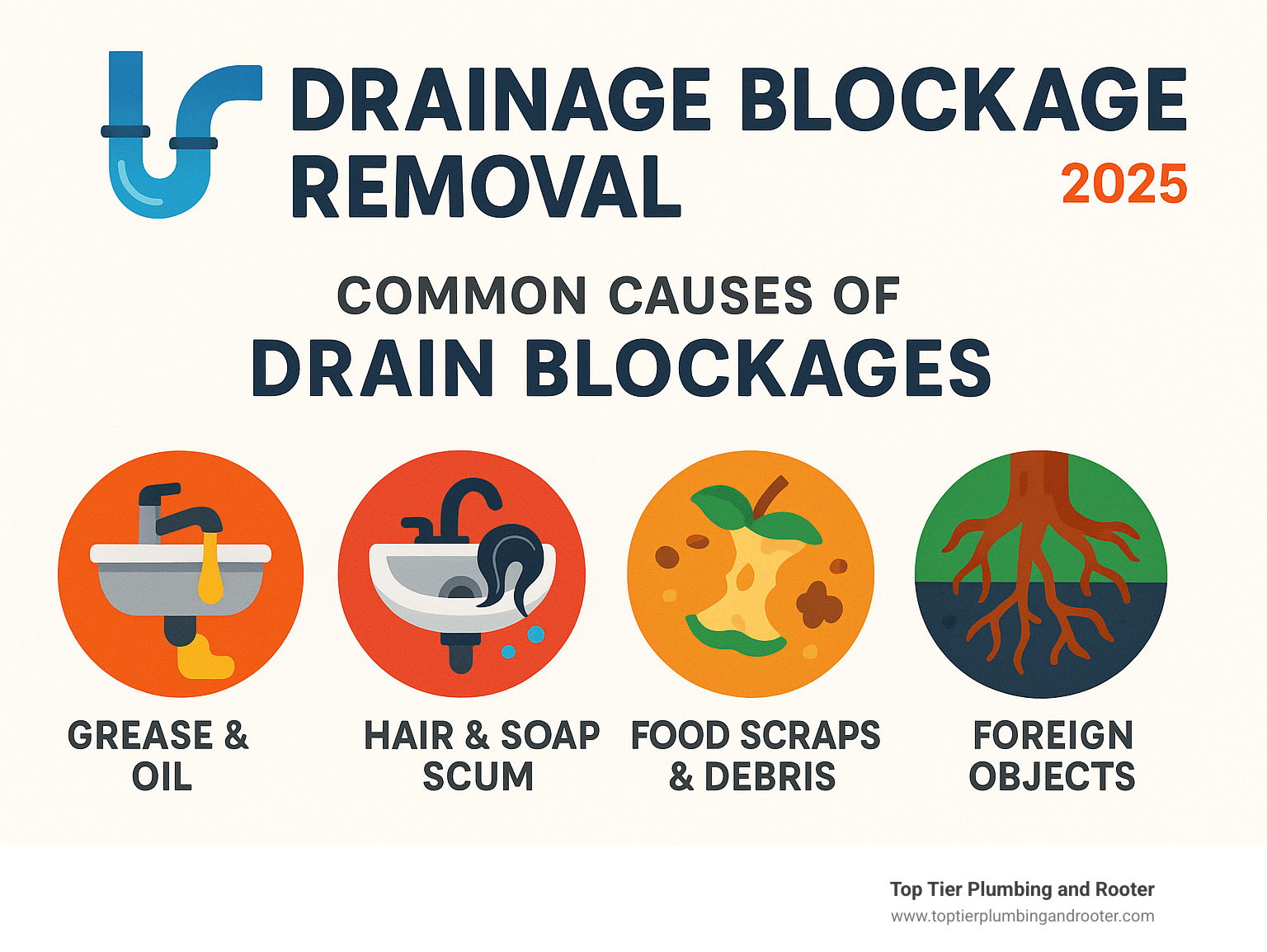
Spotting the Problem: Key Signs of a Blocked Drain
Your drains have their own way of crying for help. Think of these warning signs as your plumbing system’s way of tapping you on the shoulder before things get messy.
The most obvious clue is slow draining water in your sinks, showers, or bathtubs. What used to take seconds now takes minutes, leaving you in ankle-deep water during your shower. This sluggish drainage is the first sign that debris is building up and narrowing your pipes.
Next, you might notice gurgling sounds coming from your drains. These noises happen when air gets trapped by blockages and struggles to escape as water flows through. If you hear gurgling from one drain while using another fixture, pay attention—that’s a red flag.
Unpleasant odors from your drains are another dead giveaway. That sour, rotten smell tells you that organic matter, grease, or food particles are decomposing in your pipes. This decay leads to bacterial growth, which you don’t want lurking in your plumbing.
When water starts backing up into your sink, tub, or shower, you’ve moved from “minor annoyance” to “real problem” territory. This means the blockage has grown serious enough to stop water flow entirely. Even more concerning is when flushing your toilet causes water to back up into your shower – that’s a clear sign of main drain line trouble.
Perhaps the biggest warning sign is when multiple fixtures are affected simultaneously. If your bathroom sink, shower, and toilet are all acting up at once, especially if they’re on the same plumbing line, you’re likely dealing with a main drain blockage. This isn’t a DIY situation – it’s time to call in the professionals.
Catching these signs early can save you from dealing with major drainage blockage removal headaches down the road. Minor issues are much easier (and less expensive) to fix than full-blown plumbing emergencies.
If you’ve been ignoring these warning signs, you’ll want to read about The Hidden Dangers of Ignoring Drainage Issues: What Homeowners Need to Know. And if you’re seeing sewage backing up, don’t wait – check out Sewer Clearing Emergency: How to Identify and Address Urgent Sewage Issues for immediate guidance.
Step-by-Step Guide to Drainage Blockage Removal
Now that we know how to spot a blocked drain, let’s roll up our sleeves and tackle the problem head-on! Most drainage blockage removal situations stem from surprisingly common household culprits that build up over time in our pipes.
Grease buildup is the biggest troublemaker in kitchen drains, solidifying as it cools and trapping other debris. Hair clogs dominate bathroom drains, creating tangled messes that catch soap scum and other particles. Food particles that slip past our best intentions can accumulate, especially in garbage disposals. Sometimes foreign objects like jewelry, toys, or cotton swabs take an unexpected dive down the drain.
The real troublemakers are the underground issues – tree roots can actually rupture pipes and create major blockages in your main drain line. If you’re curious about the more serious causes behind sewer line problems, our guide on Why Do I Have a Clogged Sewer Line? covers everything you need to know.
Let’s explore some proven techniques, starting with simple solutions you can try right now and building up to more advanced tools.
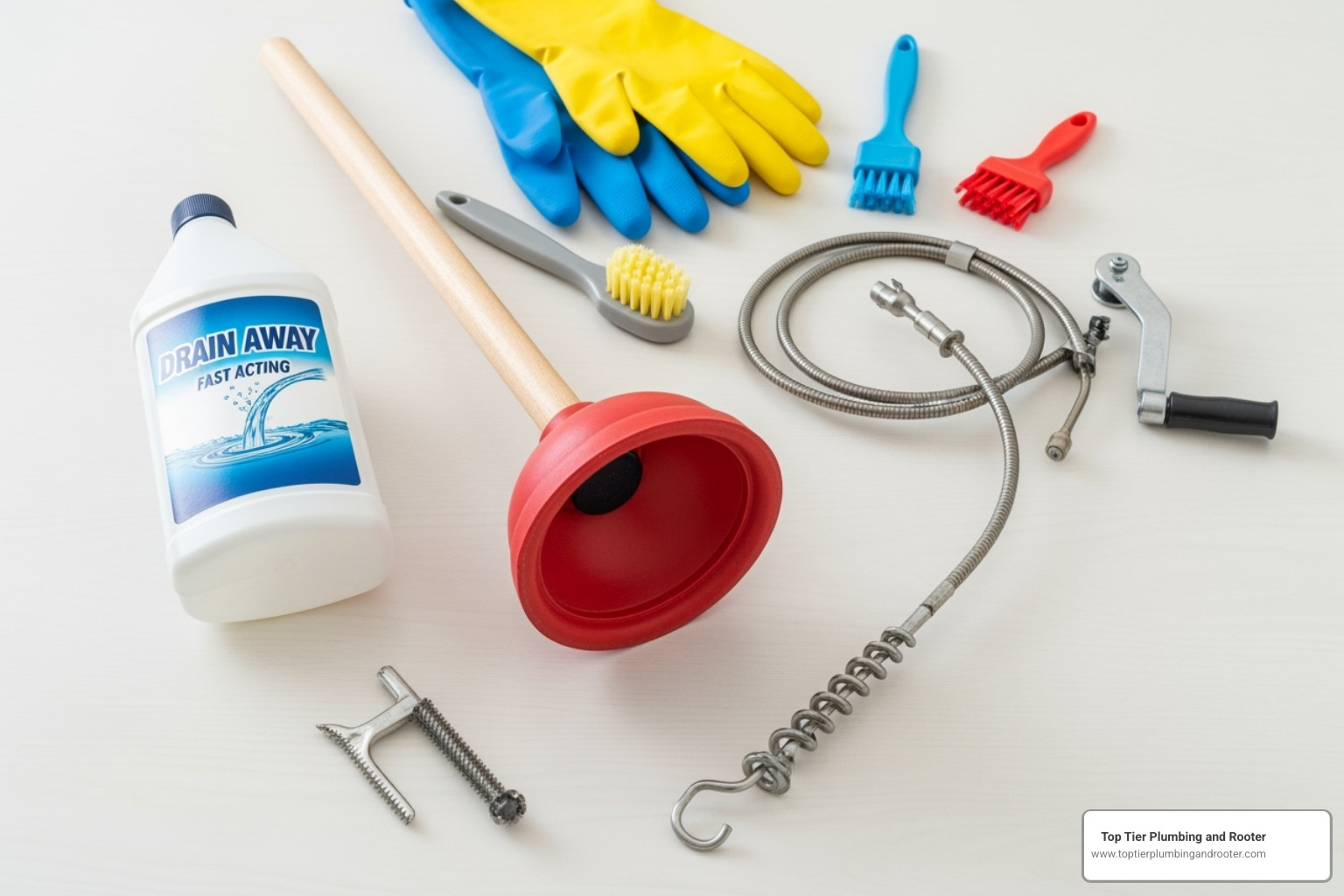
Simple DIY Drainage Blockage Removal Techniques
The beauty of many drain clogs is that they often respond beautifully to simple household remedies. Before you reach for expensive tools or harsh chemicals, let’s start with what you probably already have in your kitchen.
Boiling water is your first line of defense, especially against grease-based clogs. Remove any standing water first, then carefully pour a full pot of boiling water down the drain in two or three stages. Give it a few seconds between pours to let the heat work its magic on that stubborn grease buildup. Just be cautious with older pipes or PVC installations – extreme heat can sometimes cause more harm than good.
The baking soda and vinegar method is like a mini science experiment that actually works! Pour about half a cup of baking soda down the drain, followed immediately by an equal amount of white vinegar. You’ll hear that satisfying fizzing sound as the chemical reaction creates carbon dioxide gas that bubbles through your clog, loosening clogs from the inside out. Cover the drain quickly with a stopper or cloth to keep all that bubbly action working in your pipes, let it sit for 15-30 minutes, then flush with hot water.
Don’t underestimate plunger use – it’s not just for toilets! A cup plunger creates powerful hydraulic pressure that can dislodge stubborn blockages. Make sure you have enough water to cover the rubber cup, create a tight seal, and pump vigorously for about 30 seconds. You might be surprised how effective this old-school method can be! For bathroom-specific techniques, check out our detailed guide on Unclogging a Bathtub Drain with a Plunger.
Here’s what should never, ever go down your drains: “flushable” wipes (they’re lying – they don’t break down!), grease (it turns solid and clings to everything), coffee grounds (they create sludge), and paper towels (they’re designed to stay strong when wet). Trust us on this one – prevention is so much easier than dealing with a nasty backup later!
Advanced DIY Drainage Blockage Removal with a Drain Snake
When the simple methods meet their match, it’s time to bring in the big guns – or in this case, the humble drain auger. This flexible metal cable might look intimidating, but it’s actually quite straightforward to use and incredibly effective at reaching deeper clogs that are hiding further down your pipes.
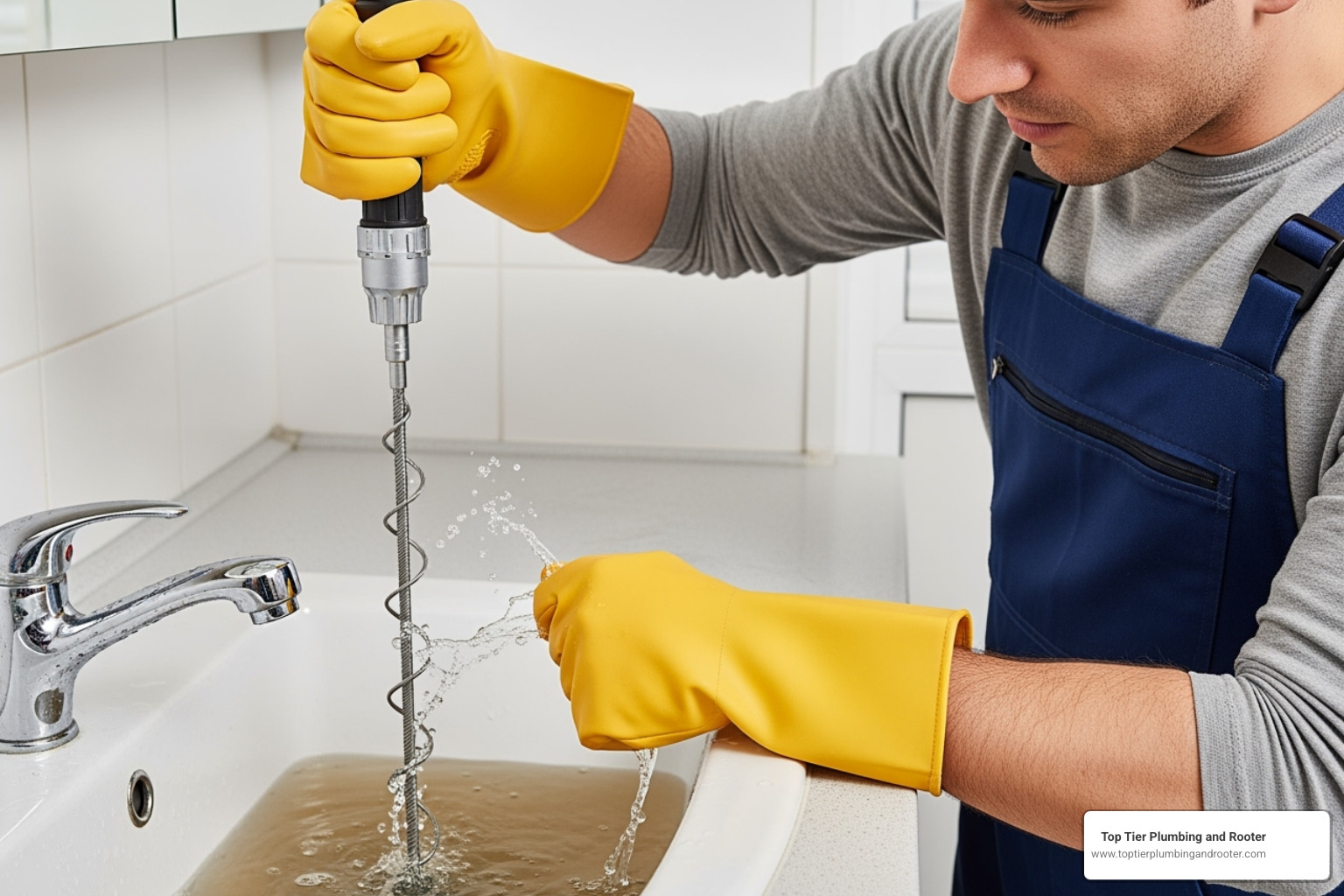
How to use a snake effectively starts with preparation – lay down towels to catch the inevitable mess and put on gloves because this can get pretty gross! Slowly feed the snake into your drain, gently twisting and pushing when you hit the natural bends in your pipes. You’ll know you’ve found the clog when you feel significant resistance that doesn’t give way like a pipe curve would.
Now comes the satisfying part – breaking up obstructions. Rotate the handle clockwise to make the auger head spin and chew through the blockage. Sometimes you can actually hook and retrieve the entire clog, which is oddly satisfying (and sometimes surprisingly disgusting!). Work the snake back and forth, breaking up the obstruction until you feel it give way.
Safety precautions are crucial here – go slowly to avoid scratching your pipes, and never force the snake if you’re meeting serious resistance. Once you’ve conquered the clog, slowly withdraw the snake and flush the drain with hot water for several minutes. For a more detailed walkthrough with visual guidance, our comprehensive guide on How to Snake a Drain will walk you through every step.
A Word of Caution on Chemical Drain Cleaners
Let’s have an honest conversation about those brightly colored bottles promising instant drain relief. While chemical drain cleaners seem like the easy solution, they often create more problems than they solve.
Pipe corrosion is the biggest concern – those harsh chemicals generate heat that can soften PVC pipes, warp plastic fittings, and eat away at older metal pipes. We’ve seen too many cases where repeated chemical use weakened pipes so badly that they eventually burst, creating a much bigger (and more expensive) problem than the original clog.
Environmental harm and toxic fumes make these products dangerous for your family and the planet. The chemicals don’t just disappear after you pour them down – they enter our water systems and can cause serious safety hazards if you accidentally splash them or breathe the fumes.
Here’s the kicker – they’re often ineffective on tough clogs anyway! They might burn a small hole through a blockage, but the bulk of the clog remains, meaning your problem will be back in no time. Meanwhile, those chemicals are still sitting in your pipes, continuing to cause damage.
For a deeper dive into why we recommend avoiding these products, read our insights on San Bernardino Plumbing Insights: Why You Should Avoid Commercial Drain Cleaners. If you’re weighing your options, our comparison guide Chemical vs. Mechanical Drain Cleaning: Pros and Cons gives you all the facts you need to make an informed decision.
When to Call a Professional for a Stubborn Blockage
Look, we totally get the satisfaction that comes with fixing a plumbing problem yourself. There’s something deeply rewarding about conquering that stubborn clog with nothing but determination and a plunger! But sometimes, despite our best DIY efforts, a drain blockage is simply beyond what household tools and weekend warrior spirit can handle.
Knowing when to wave the white flag and call in the professionals isn’t about admitting defeat – it’s about being smart with your time, money, and sanity. More importantly, it’s about preventing what might be a minor inconvenience from turning into a major disaster that could cost you thousands in repairs.
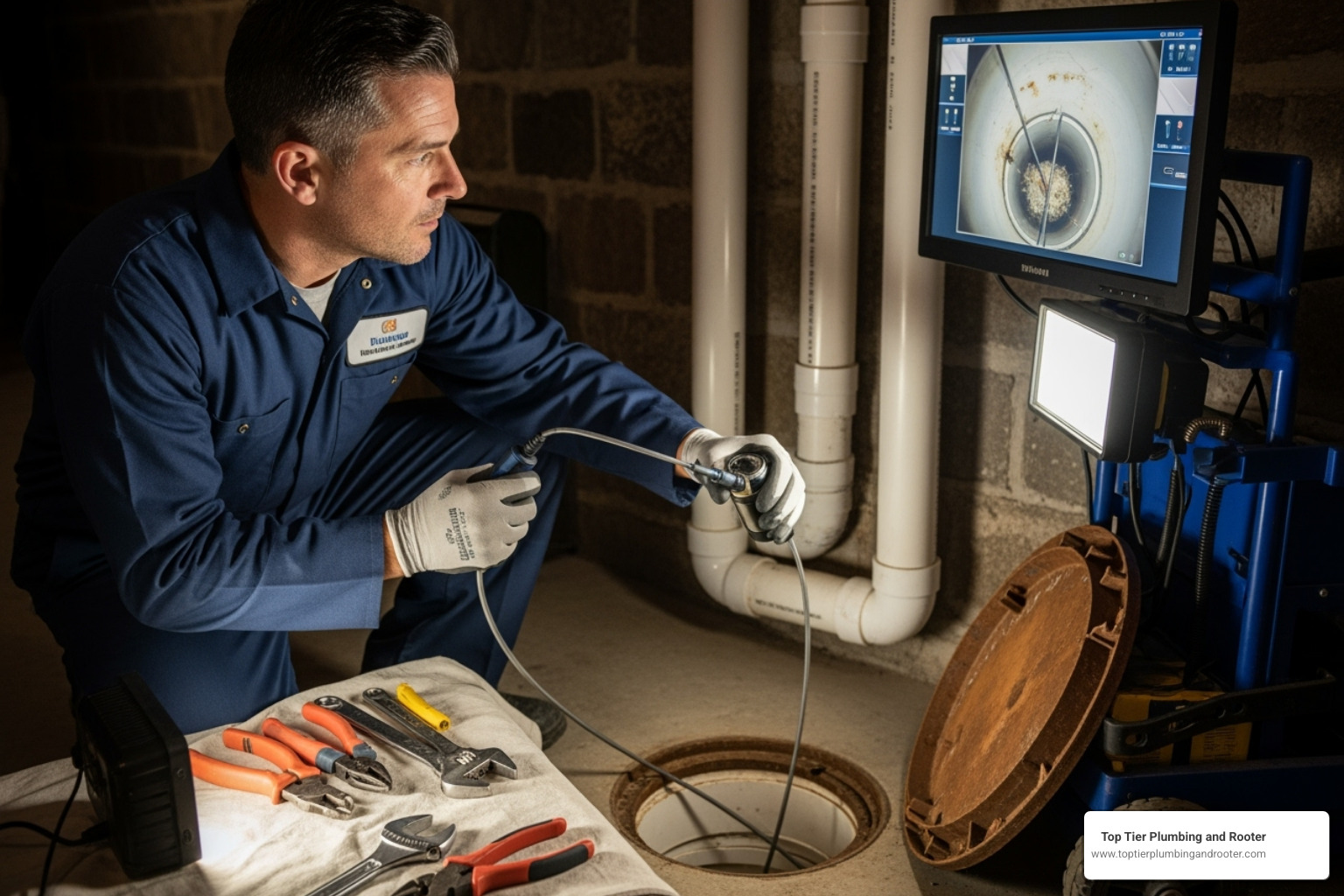
Here’s when you should definitely pick up the phone and call Top Tier Plumbing and Rooter:
Recurring clogs are like that annoying friend who keeps showing up uninvited – they’re trying to tell you something important. If the same drain keeps getting blocked shortly after you’ve cleared it, there’s almost certainly a deeper issue at play. Maybe there’s pipe damage, a persistent buildup that your DIY methods can’t fully remove, or even a structural problem with your plumbing. Continuing to treat the symptom without addressing the cause is like putting a Band-Aid on a broken pipe.
When multiple drains are slow or completely blocked, especially if they’re on the same plumbing line (like your bathroom sink and toilet), you’re likely dealing with a main sewer line clog. This isn’t a DIY situation – it requires professional equipment and expertise to diagnose and fix properly.
Sewage backup is an absolute emergency that demands immediate professional attention. If you see raw sewage backing up into your toilets, showers, or sinks, stop what you’re doing and call us right away. This isn’t just gross – it’s a serious health hazard that can contaminate your entire home.
If you’ve already tried the DIY methods we’ve covered – the boiling water, baking soda and vinegar, plunging, and even snaking – and the clog is still laughing at your efforts, it’s time to bring in the big guns. Continuing to force the issue can actually make things worse by pushing the clog deeper into your pipes or even damaging the plumbing itself.
Tree roots are particularly sneaky troublemakers. If you have large trees in your yard, their roots can infiltrate your sewer lines through tiny cracks, growing into major blockages over time. No amount of DIY effort will clear tree roots – they require specialized cutting equipment and professional expertise to remove safely.
The bottom line? Attempting to fix complex plumbing issues yourself can be dangerous and costly. For more insight into why certain plumbing tasks are best left to the experts, check out The Hidden Dangers of DIY Plumbing: Why You Should Hire a Professional.
Professional Methods: Hydro-Jetting and More
When you call Top Tier Plumbing and Rooter, we arrive equipped with advanced tools and years of expertise to tackle even the most stubborn drainage blockage removal challenges. Our methods go far beyond what’s possible with household tools, delivering results that are both thorough and long-lasting.
| Feature | DIY Methods (Plunger, Snake, Baking Soda/Vinegar) | Professional Services (Hydro-Jetting, Pro Augers) |
|---|---|---|
| Effectiveness | Limited to surface-level clogs | Clears deep, stubborn blockages completely |
| Pipe Cleaning | May only punch hole through clog | Cleans entire pipe diameter thoroughly |
| Reach | Shallow penetration (few feet) | Can reach up to 200 feet into pipes |
| Root Removal | Cannot handle tree roots | Specialized cutting equipment removes roots |
| Pipe Safety | Risk of damage from forcing tools | Professional techniques protect pipe integrity |
| Diagnostic Capability | Guesswork about clog location/type | Video inspection shows exact problem |
| Long-term Results | Temporary fixes, clogs often return | Prevents future blockages for months/years |
| Grease Removal | Limited effectiveness | High-pressure water removes all buildup |
Hydro-jetting is our secret weapon and honestly, it’s pretty amazing to watch in action. This method uses high-pressure water jets – we’re talking up to 4,300 PSI of cleaning power – to thoroughly scour the inside of your pipes. Unlike traditional snaking that might just punch a hole through the clog, hydro-jetting cleans the entire pipe diameter, leaving it as clean as the day it was installed.
Think of it like the difference between poking a hole in a dirty window versus pressure-washing the entire surface. The hydro-jetting process can clear drains up to 200 feet away and removes everything – grease, sand, roots, soap buildup, and other debris that’s been accumulating for years. Our team uses specialized rotating nozzles and cutting heads to ensure we get every bit of buildup out of there.
Video camera inspection is another game-changer that we use for persistent or mysterious clogs. We insert a small, high-resolution camera into your pipes, giving us a real-time view of exactly what’s happening down there. This isn’t just cool technology for the sake of it – it allows us to see the precise nature and location of the blockage, plus any pipe damage like cracks, corrosion, or root intrusion. No more guessing games!
Our professional-grade augers and snakes are like the heavy-duty cousins of the tools you can rent at the hardware store. These motorized units can reach much further, cut through tougher blockages, and have the power to handle clogs that would laugh at a home-grade snake.
When tree roots are the culprit, we have specialized cutting equipment designed specifically for this challenge. After removing the roots, we often recommend preventive measures like pipe relining or other repairs to stop future root intrusion.
You can learn more about our hydro-jetting services at Hydrojetting and find why we believe it’s the Superior Method of Drain Cleaning in Riverside.
The Benefits of Professional Drain Cleaning
Investing in professional drain cleaning services offers advantages that go way beyond just getting your water flowing again. When you choose Top Tier Plumbing and Rooter, you’re not just paying for a quick fix – you’re investing in the long-term health of your entire plumbing system.
Thorough cleaning is probably the biggest difference between our professional services and DIY methods. While home remedies might provide temporary relief by creating a small opening in the blockage, our techniques ensure the entire pipe is cleared of debris. It’s like the difference between sweeping dirt under the rug versus actually vacuuming the whole room – one solution lasts, the other doesn’t.
Pipe safety is another crucial advantage. Our experienced plumbers know exactly how to clean your pipes without causing damage. Methods like hydro-jetting are incredibly powerful yet completely safe for your plumbing system when used correctly. This preserves your pipes’ integrity and extends their lifespan, which is a stark contrast to harsh chemical cleaners that can corrode and weaken pipes over time.
We focus on long-term solutions rather than quick Band-Aid fixes. Our team doesn’t just clear the immediate clog – we identify and address the root cause of the problem. Whether it’s a structural issue, persistent grease buildup, or tree root intrusion, we provide solutions that prevent future blockages. This approach saves you time, money, and the frustration of dealing with the same problem over and over again.
Our expertise means we can eliminate even the toughest clogs competently and correctly. No matter how stubborn or deep the blockage, we have the right tools and knowledge to get the job done right the first time. You won’t have to worry about whether the problem is truly fixed or if it’ll come back next week.
Preventing future damage is another significant benefit of regular professional drain cleaning. Minor issues that go unaddressed can escalate into major plumbing disasters – think burst pipes, extensive water damage from backups, or sewage flooding your basement. Our preventive approach catches these problems early, before they become expensive emergencies.
Perhaps most importantly, professional drain cleaning provides peace of mind. Knowing that your drains are thoroughly cleaned and your plumbing system is in expert hands is invaluable. You can go about your daily life without worrying about unexpected backups, slow drains, or plumbing emergencies disrupting your routine.
For homeowners in Riverside and San Bernardino counties specifically, we understand the unique challenges that come with our local climate and aging infrastructure. Learn more about how our services benefit local residents in The Benefits of Professional Drain Cleaning Services in Riverside and San Bernardino County.
Preventing Future Clogs: Simple Maintenance Habits
After successfully tackling a drain blockage, the last thing you want is for it to happen again. The good news? Most drainage blockage removal situations are completely preventable with a few simple, consistent habits. Think of it as giving your drains a little TLC – they’ll reward you by flowing smoothly for years to come.
Drain strainers are your first line of defense and honestly, they’re game-changers. These inexpensive little devices catch hair, food particles, soap scum, and other debris before they can sneak into your pipes and cause trouble. Pop them into all your sinks, showers, and bathtubs, and make it a habit to empty them regularly. Trust us, cleaning a strainer is way easier than dealing with a completely blocked drain!
Your kitchen drains especially appreciate a good regular flushing with hot water. Once a week, run hot water down your kitchen sink for a few minutes to help melt and wash away minor grease and soap buildup before it becomes a bigger problem. For bathroom drains, running hot water for a minute or two after each shower helps keep things flowing smoothly.
Here’s where many homeowners go wrong: proper grease disposal. Never, ever pour cooking grease, fats, or oils down your kitchen sink. They might be liquid when they’re hot, but they solidify as they cool, creating a sticky mess that clings to your pipes and catches everything else that comes down the drain. Instead, pour cooled grease into an old can or jar, let it solidify completely, and toss it in the trash. As plumbing experts always say, watching what you pour down your drains is one of the smartest habits you can develop.
Mindful flushing is another simple but crucial habit. Your toilet isn’t a trash can – only human waste and toilet paper should go down there. Those “flushable” wipes we mentioned earlier? They’re not really flushable. Neither are feminine hygiene products, paper towels, or cotton swabs. Even some luxury toilet papers can be problematic if they’re extra thick and slow to break down.
If you have a garbage disposal, use it wisely. While it’s convenient, it’s not meant to handle everything. Avoiding harsh chemicals is equally important – those store-bought drain cleaners might seem like a quick fix, but they can actually damage your pipes over time. Stick to gentler, natural solutions for minor issues, and call professionals like us for persistent problems.
The secret weapon in preventing future clogs? Schedule regular professional drain cleaning. Even with perfect habits, some buildup is inevitable. Think of it like getting your car’s oil changed – regular maintenance prevents bigger, costlier problems down the road. Professional cleaning can remove accumulated debris, grease, and even catch early-stage tree root intrusion before it becomes a major headache.
These simple habits can dramatically reduce your chances of dealing with blocked drains again. Want more detailed strategies? Check out The Best Ways to Prevent Clogged Drains in Your Kitchen and Bathroom for room-specific tips. And don’t underestimate The Importance of Regular Drain Cleaning in Riverside and San Bernardino County Homes – our local climate and conditions make regular maintenance especially valuable.
An ounce of prevention really is worth a pound of cure. Your future self will thank you for taking these simple steps today!
Conclusion
Drainage blockage removal doesn’t have to be the nightmare you thought it was! Throughout this guide, we’ve armed you with everything you need to tackle those pesky clogs that seem to appear at the worst possible moments. From recognizing the early warning signs like slow-draining water and mysterious gurgling sounds to understanding when that unpleasant smell means it’s time to take action.
We started with the gentlest approaches – sometimes all you need is a good boiling water flush or that satisfying baking soda and vinegar fizz to get things moving again. When those simple tricks don’t do the job, you learned how to wield a drain snake like a pro and why those tempting chemical cleaners are best left on the store shelf.
But here’s what we really want you to remember: there’s no shame in knowing when you’ve met your match. When clogs keep coming back, multiple drains start acting up, or you spot any signs of sewage backup, it’s time to call in the cavalry. That’s where our professional hydro-jetting and video inspection services shine, clearing even the most stubborn blockages and giving you solutions that actually last.
The real secret weapon? Prevention. Those simple daily habits we talked about – using drain strainers, properly disposing of grease, and being mindful about what goes down your pipes – can save you from future headaches and keep your drains flowing smoothly.
For homeowners in Riverside and San Bernardino counties, you don’t have to face persistent or severe blockages alone. Our team at Top Tier Plumbing and Rooter brings the expertise and professional-grade equipment needed to solve your drainage problems safely and effectively. We’re here to get your water flowing freely again and keep it that way.
Ready to say goodbye to standing water for good? Keep Your Drains Flowing with Professional Drain Cleaning – because life’s too short to spend it plunging drains!


